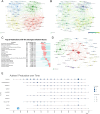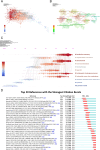Research trends of selective internal radiation therapy for liver cancer: a bibliometric analysis
- PMID: 40660222
- PMCID: PMC12257699
- DOI: 10.1186/s13014-025-02690-z
Research trends of selective internal radiation therapy for liver cancer: a bibliometric analysis
Abstract
Background: Liver cancer is a major contributor to cancer-related mortality. Selective internal radiation therapy (SIRT) for liver cancer has garnered increasing attention. This study aims to comprehensively describe the current status, hotspots and trends of SIRT.
Methods: Publications from January 1, 1994, to May 31, 2024, were retrieved from the Web of Science Core Collection. CiteSpace, VOSviewer, the Bibliometrix package from R software, and an online analytical platform were used for knowledge mapping analysis and visualization.
Results: A total of 2046 publications were retrieved from the Web of Science Core Collection. The number of publications related to SIRT for liver cancer has been continuously increasing, particularly since 2005. The United States led in publications, and a strong collaboration network was observed among countries, particularly within Europe and America. The Northwestern University had the highest number of publications in the field of SIRT. Co-citation analysis identified "predictive dosimetry" and "atezolizumab" as current focal points within the field. High-frequency keywords include "transarterial radioembolization", "Y90 microspheres", "hepatocellular carcinoma", while recent citation bursts are predominantly centered on "lung shunt fraction," "tumor dose," "systemic therapy," "radiation segmentectomy," "Holmium-166," etc. CONCLUSION: As a local treatment, SIRT exhibits significant promise for its future role in the management of hepatic malignancies. Numerous studies on SIRT are actively in progress. Our study suggests that radiation segmentectomy may emerge as an important treatment in the future. Moreover, personalized dosimetry, the combination of SIRT with immunotherapy, and the development of novel radioactive agents are identified as pivotal areas for future research.
Keywords: Bibliometric analysis; Bibliometrix; Citespace; Liver cancer; Radioembolization; Selective internal radiation therapy; VOSviewer.
© 2025. The Author(s).
Conflict of interest statement
Declarations. Ethics approval and consent to participate: This study is a bibliometric analysis, with all primary data extracted from the Web of Science core Collection database. As the research did not involve original data from human subjects, it did not encompass any interventions, experiments, or surveys that could potentially impact personal privacy, rights, or welfare. So ethics approval and consent to participate are not applicable. Consent for publication: Not applicable. Competing interests: The authors declare no competing interests.
Figures







Similar articles
-
Research status, hotspots and perspectives of artificial intelligence applied to pain management: a bibliometric and visual analysis.Updates Surg. 2025 Jun 28. doi: 10.1007/s13304-025-02296-w. Online ahead of print. Updates Surg. 2025. PMID: 40580377
-
Knowledge graph and bibliometric analysis of inflammatory indicators in ovarian cancer.Front Oncol. 2025 Jun 30;15:1533537. doi: 10.3389/fonc.2025.1533537. eCollection 2025. Front Oncol. 2025. PMID: 40661780 Free PMC article.
-
Driving innovations in cancer research through spatial metabolomics: a bibliometric review of trends and hotspot.Front Immunol. 2025 Jun 10;16:1589943. doi: 10.3389/fimmu.2025.1589943. eCollection 2025. Front Immunol. 2025. PMID: 40557160 Free PMC article.
-
Comprehensive Global Analysis of Future Trends in Artificial Intelligence-Assisted Veterinary Medicine.Vet Med Sci. 2025 May;11(3):e70258. doi: 10.1002/vms3.70258. Vet Med Sci. 2025. PMID: 40145983 Free PMC article.
-
A bibliometric mapping study of the literature on the quality of life of people living with HIV.AIDS Res Ther. 2025 Jul 18;22(1):69. doi: 10.1186/s12981-025-00772-2. AIDS Res Ther. 2025. PMID: 40682052 Free PMC article.
References
-
- Singal AG, Kanwal F, Llovet JM. Global trends in hepatocellular carcinoma epidemiology: implications for screening, prevention and therapy. Nat Reviews Clin Oncol. 2023;20(12):864–84. - PubMed
-
- Liapi E, Geschwind JF. Intra-arterial therapies for hepatocellular carcinoma: where do we stand? Ann Surg Oncol. 2010;17(5):1234–46. - PubMed
-
- Sangro B, Iñarrairaegui M, Bilbao JI. Radioembolization for hepatocellular carcinoma. J Hepatol. 2012;56(2):464–73. - PubMed
-
- Salem R, Thurston KG. Radioembolization with 90Yttrium microspheres: A State-of-the-Art brachytherapy treatment for primary and secondary liver malignancies. J Vasc Interv Radiol. 2006;17(8):1251–78. - PubMed
Publication types
MeSH terms
Grants and funding
LinkOut - more resources
Full Text Sources
Medical
Research Materials

